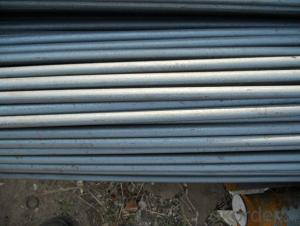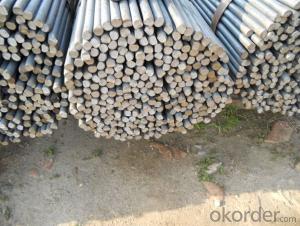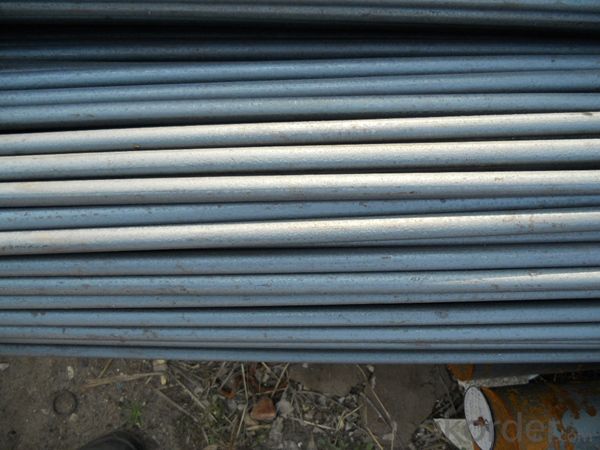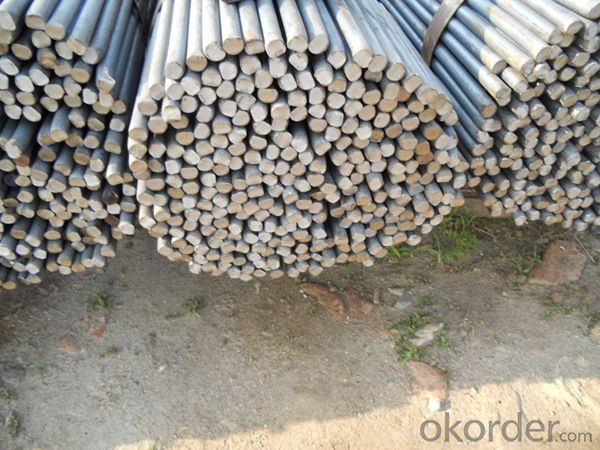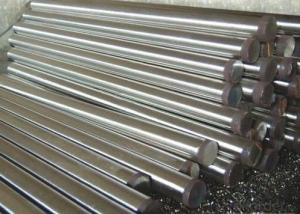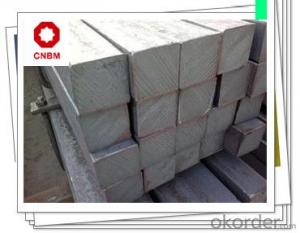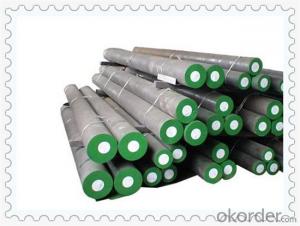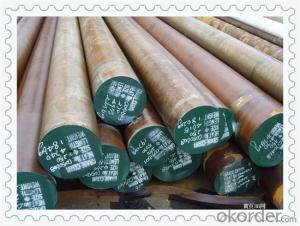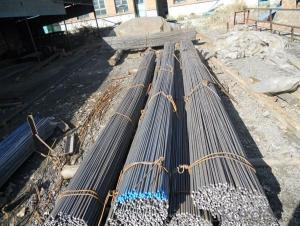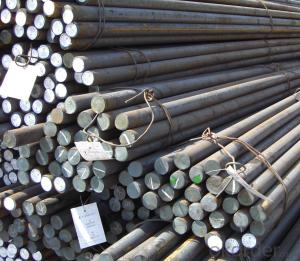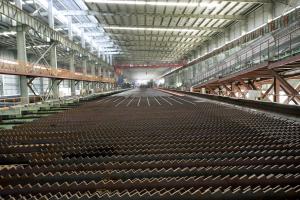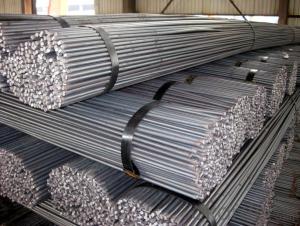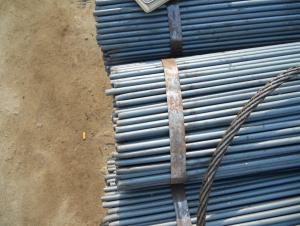Low Carbon Hot Rolled Steel Round Bars for Bults and Nults
- Loading Port:
- Tianjin
- Payment Terms:
- TT or LC
- Min Order Qty:
- 25 m.t.
- Supply Capability:
- 200000 m.t./month
OKorder Service Pledge
OKorder Financial Service
You Might Also Like
Product Description:
OKorder is offering Low Carbon Hot Rolled Steel Round Bars for Bults and Nults at great prices with worldwide shipping. Our supplier is a world-class manufacturer of steel, with our products utilized the world over. OKorder annually supplies products to European, North American and Asian markets. We provide quotations within 24 hours of receiving an inquiry and guarantee competitive prices.
Product Applications:
1. Low Carbon Hot Rolled Steel Round Bars for Bults and Nultsis mostly used for straight bundles supply, and used for steel, bolts and various mechanical parts. While the bigger round bar, or more than 25mm hot rolled bar, is mainly for the manufacture of mechanical parts or for seamless steel billet.
2. Low Carbon Hot Rolled Steel Round Bars for Bults and Nultsis used in construction and a large number of architectural and engineering structures.
3. Besides, we can supply some especial material steel round bar that can be used for main shaft of steamer, hummer shank, with big section and supper force.
Product Advantages:
OKorder's Low Carbon Hot Rolled Steel Round Bars for Bults and Nults are durable, strong, and resist corrosion.
1. The steel in which the main interstitial alloying constituent is carbon in the range of 0.12–2.0%.
2. As the carbon percentage content rises, steel has the ability to become harder and stronger through heat treating; however it becomes less ductile.
3. Regardless of the heat treatment, higher carbon content reduces weld ability. In carbon steels, the higher carbon content lowers the melting point
Main Product Features:
· Premium quality
· Prompt delivery & seaworthy packing (30 days after receiving deposit)
· Corrosion resistance
· Can be recycled and reused
· Mill test certification
· Professional Service
· Competitive pricing
Specifications of Low Carbon Hot Rolled Steel Round Bars for Bults and Nults
1. Grade: Q195, Q235, A36, SS400, Q345
2. Material: Mild carbon steel
3. Diameter: 8mm-150mm
4. Length: 6m, 9m, 12m
5. Quenching methods: oil quenching, air cooling or salt bath quenching
6. Heat treatment: Isothermal annealing temperature is 800~880 °C, with 10~20 °C, the furnace cooling to about 600 °C


Packaging & Delivery of Low Carbon Hot Rolled Steel Round Bars for Bults and Nults
Packaging Detail: All goods are packed in bundle with steel strips and shipped by break bulk vessel or container (depend on target market and different ports)
Delivery Detail: 45 days
Trade terms: FOB, CFR, CIF
MOQ: 25 tons per specification; we can negotiate the quantity if the specification is normal or we have stock of one specification.
Weight: The price invoicing on theoretical weight basis or actual weight basis depends on customer’s request.
Shipment: The shipment of bulk break or container is depends on customer’s request and the situation of the port of destination.
Documents given: Full set of original clean on board bill of lading; Original signed commercial invoice; Original packing list; Policy of insurance; Certificate of origin and what the target market needs.
Quality Assurance of Low Carbon Hot Rolled Steel Round Bars for Bults and Nults
1. We will strictly inspect our production that we sold according to the customer’s request.
2. Quality should be in conformity with the specification of the manufacturer. Quantity and packing conditions should be in conformity with the term in the contract.
3. Should the packing found damaged, the buyer has the right to claim to the seller.
FAQ:
Q1: Can fit in the containers of 20fts the steel beams of 6M?
A1: No proble, we can put them into the containers in the form sideling.
Q2: The products are invoicing on theoritical weight or on actual weight?
A2: We can do it in both manners, according to the customers' request.
Q3: How soon can we receive the product after purchase?
A3: Within three days of placing an order, we will begin production. The specific shipping date is dependent upon international and government factors, but is typically 7 to 10 workdays.
- Q: Difference between cold drawn round steel and round steel
- Cold formed steel allows partial buckling of the cross section, thus taking full advantage of the post buckling capacity of the member, while the hot-rolled section does not allow partial buckling of the cross section.
- Q: What is the difference between a bright and a cold finished steel round bar?
- A bright steel round bar and a cold finished steel round bar are two distinct types of steel bars that differ in their manufacturing processes and resulting characteristics. A bright steel round bar, also known as a turned or polished bar, undergoes a process called turning or polishing. During this process, the rough steel bar is rotated on a lathe machine and a cutting tool is applied to remove the outer layer of the bar, resulting in a smooth and shiny surface. This process not only enhances the appearance of the bar but also improves its dimensional accuracy and surface finish. Bright steel round bars are commonly used in applications where aesthetics and a high-quality surface finish are important, such as architectural components, decorative items, and certain automotive parts. On the other hand, a cold finished steel round bar undergoes a different manufacturing process called cold drawing or cold rolling. In this process, the hot-rolled steel bar is passed through a series of dies at room temperature, reducing its diameter and increasing its length. This cold working process gives the steel bar improved mechanical properties, such as increased tensile strength, improved yield strength, and enhanced dimensional accuracy. Cold finished steel round bars are often used in applications that require high strength and precision, such as shafts, gears, bolts, and tools. In summary, the main difference between a bright steel round bar and a cold finished steel round bar lies in their manufacturing processes and resulting characteristics. While a bright steel round bar is turned or polished to achieve a smooth and shiny surface, a cold finished steel round bar undergoes cold drawing or rolling to enhance its mechanical properties and dimensional accuracy. The choice between these two types of steel bars depends on the specific requirements of the application, such as the need for aesthetics, surface finish, strength, or precision.
- Q: Are steel round bars used in the aerospace industry?
- Yes, steel round bars are commonly used in the aerospace industry for various applications such as structural components, landing gears, and engine parts. The high strength, durability, and excellent mechanical properties of steel make it an ideal material choice for aircraft manufacturing.
- Q: Can steel round bars be used in the production of couplings?
- Indeed, couplings can be produced using steel round bars. These bars are widely employed across various industrial sectors owing to their robustness, endurance, and versatility. In terms of coupling manufacturing, steel round bars furnish the essential structural integrity and dependability demanded by such components. They can be manipulated, forged, or molded to conform to specific coupling designs and specifications. Additionally, steel round bars boast exceptional resistance against corrosion, a pivotal factor in ensuring the longevity and operational efficacy of couplings in diverse settings. All in all, steel round bars serve as an appropriate material selection for coupling production, guaranteeing the requisite strength and durability necessary for seamless and trustworthy coupling operations.
- Q: Can steel round bars be used in the packaging industry?
- Yes, steel round bars can be used in the packaging industry. They are commonly used for constructing pallets, crates, and other packaging materials that require strength, durability, and load-bearing capacity. Steel round bars provide a robust and reliable solution for packaging heavy and bulky items, ensuring safe transportation and storage.
- Q: What are the cost considerations for steel round bars?
- The cost of steel round bars can vary depending on several factors. Firstly, the cost can be greatly influenced by the type and grade of steel used in production. Different types of steel, such as carbon steel, alloy steel, or stainless steel, have varying costs due to differences in their composition and properties. Higher grade steel, which offers superior strength and durability, tends to be more expensive compared to lower grade options. Secondly, the cost is affected by the size and dimensions of the round bars. Larger diameter and length of the bars require more raw material and additional processing, resulting in higher costs. Moreover, specialized shapes or custom sizes may necessitate extra manufacturing steps or tooling, which can increase the overall price. The quantity or volume of round bars ordered can also impact the cost. Bulk orders typically benefit from economies of scale, leading to reduced unit costs. Additionally, longer-term contracts or partnerships with suppliers can result in better pricing agreements. It is important to consider transportation and logistics expenses as well. The cost of shipping steel round bars can vary based on factors such as distance, mode of transportation, and handling requirements. International shipping, for example, may involve additional customs duties and taxes. Lastly, market conditions and fluctuations in the steel industry can have an impact on the cost of round bars. Factors like supply and demand, raw material costs, and currency exchange rates can all influence the final price. It is crucial to stay updated with market trends and work closely with suppliers to negotiate favorable pricing. To ensure that the cost of steel round bars aligns with your budget and meets your specific requirements, it is essential to conduct thorough research, compare quotes from multiple suppliers, and evaluate the quality-to-price ratio before making a decision.
- Q: What are the factors to consider when selecting a steel round bar?
- When selecting a steel round bar, there are several factors that should be taken into consideration. Firstly, it is important to consider the grade of steel. Different grades of steel have varying properties and strengths, so the specific application and requirements should be evaluated. For example, if high corrosion resistance is needed, stainless steel grades like 304 or 316 may be suitable, whereas for structural applications, carbon steel grades like A36 or 1018 may be more appropriate. Secondly, the dimensions and size of the round bar should be considered. This includes the diameter, length, and tolerance requirements. The size should be chosen based on the specific application, load-bearing capacity, and the available space for installation. Thirdly, the surface finish and condition of the round bar should be assessed. This includes factors such as surface roughness, straightness, and any surface defects. The surface finish should be selected based on the desired aesthetics, functional requirements, and the manufacturing process. Another important factor is the availability and cost of the steel round bar. It is crucial to consider the availability of the desired grade and size from suppliers, as well as the associated cost. It is advisable to compare prices from different suppliers to ensure the best value for money. Furthermore, the required mechanical properties of the steel round bar should be evaluated. This includes factors such as tensile strength, yield strength, hardness, and ductility. The mechanical properties should align with the intended application and load-bearing requirements. Lastly, it is essential to consider any additional requirements or certifications that may be needed. This could include compliance with specific industry standards (e.g., ASTM, ISO), certifications (e.g., RoHS, REACH), or specific testing requirements (e.g., ultrasonic testing, impact testing). In conclusion, when selecting a steel round bar, it is important to consider the grade, dimensions, surface finish, availability, cost, mechanical properties, and any additional requirements. Taking into account these factors will help ensure that the steel round bar chosen is suitable for the intended application and meets all necessary specifications.
- Q: How are steel round bars tested for quality?
- To ensure that steel round bars meet the necessary standards and specifications, various methods are employed to test their quality. One commonly used test is visual inspection, which involves carefully examining the bars for any visible defects such as surface cracks, pits, or deformities. This task is carried out by highly skilled personnel who have been trained to identify irregularities that could potentially impact the quality of the steel bars. Another crucial test is dimensional inspection, which assesses the diameter, length, and straightness of the round bars. This ensures that the bars fall within the specified tolerances and meet the required dimensions for their intended use. Mechanical testing is also conducted to evaluate the strength and mechanical properties of the steel bars. This includes tests like tensile strength, yield strength, and elongation, which determine how the bars will perform under different loads and conditions. Specialized equipment is used to carry out these tests, providing important information about the structural integrity and quality of the steel bars. Moreover, chemical composition analysis is performed to verify that the steel bars have the correct proportions of various elements, such as carbon, manganese, and alloying elements. This analysis is crucial as it determines the suitability of the bars for specific applications and ensures that they possess the desired characteristics. Additionally, non-destructive testing methods, such as ultrasonic testing, magnetic particle inspection, or dye penetrant testing, may also be employed. These techniques can detect internal or surface defects that may not be visible to the naked eye, providing further confidence in the quality and integrity of the steel bars. In summary, a combination of visual inspection, dimensional inspection, mechanical testing, chemical composition analysis, and non-destructive testing methods is used to thoroughly assess the quality of steel round bars. These rigorous testing processes are essential in ensuring that the bars meet the required standards and specifications, guaranteeing customers high-quality and reliable steel products.
- Q: Are steel round bars resistant to impact?
- In general, steel round bars exhibit resistance against impacts. Steel is renowned for its remarkable strength and durability, rendering it highly impervious to forces and impacts. Additionally, the circular configuration of these bars aids in evenly dispersing the impact, thereby diminishing the likelihood of deformation or fracture. Nevertheless, it is crucial to acknowledge that the steel's resistance to impact may vary depending on the grade and quality, as well as the magnitude and characteristics of the impact force.
- Q: Can steel round bars be used in the production of electrical equipment?
- Yes, steel round bars can be used in the production of electrical equipment. Steel is a versatile material with various properties that make it suitable for different applications, including electrical equipment. Steel round bars can be used to manufacture components such as shafts, connectors, and structural supports in electrical equipment. The strength and durability of steel make it a reliable choice for these applications, as it can withstand the mechanical stresses and environmental conditions that electrical equipment may be exposed to. Additionally, steel can provide good electrical conductivity and magnetic properties, which are important characteristics for certain electrical components. However, it is worth noting that steel round bars may need to undergo additional processes such as machining, heat treatment, or surface finishing to meet specific requirements for electrical equipment production.
Send your message to us
Low Carbon Hot Rolled Steel Round Bars for Bults and Nults
- Loading Port:
- Tianjin
- Payment Terms:
- TT or LC
- Min Order Qty:
- 25 m.t.
- Supply Capability:
- 200000 m.t./month
OKorder Service Pledge
OKorder Financial Service
Similar products
Hot products
Hot Searches
